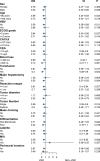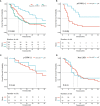Prognostic Value of Lymph Node Dissection for Intrahepatic Cholangiocarcinoma Patients With Clinically Negative Lymph Node Metastasis: A Multi-Center Study From China
- PMID: 33777738
- PMCID: PMC7991319
- DOI: 10.3389/fonc.2021.585808
Prognostic Value of Lymph Node Dissection for Intrahepatic Cholangiocarcinoma Patients With Clinically Negative Lymph Node Metastasis: A Multi-Center Study From China
Abstract
Background: The clinical value of lymph-node dissection (LND) for intrahepatic carcinoma (ICC) patients with clinically negative lymph node metastasis (LNM) remains unclear; hence we conducted a multi-center study to explore it.
Methods: Patients who were diagnosed ICC with clinically negative LNM and underwent hepatectomy with or without LND from December 2012 to December 2015 were retrospectively collected from 12 hepatobiliary centers in China. Overall survival (OS) was analyzed using the Kaplan-Meier method, and then subgroup analysis was conducted stratified by variables related to the prognosis.
Results: A total of 380 patients were eligible including 106 (27.9%) in the LND group and 274 (72.1%) in the non-LND group. Median OS in the LND group was slightly longer than that in the non-LND group (24.0 vs. 18.0 months, P = 0.30), but a significant difference was observed between the two groups (24.0 vs. 14.0 months, P = 0.02) after a well-designed 1:1 propensity score matching without increased severe complications. And, LND was identified to be one of the independent risk factors of OS (HR = 0.66, 95%CI = 0.46-0.95, P = 0.025). Subgroup analysis in the matched cohort showed that patients could benefit more from LND if they were male, age <60 years, had no HBV infection, with ECOG score <2, CEA ≤5 ug/L, blood loss ≤400 ml, transfusion, major hepatectomy, resection margin ≥1 cm, tumor size >5 cm, single tumor, mass-forming, no satellite, no MVI, and no perineural invasion (all P < 0.05). Furthermore, only patients with pathologically confirmed positive LNM were found to benefit from postoperative adjuvant therapy (P < 0.001).
Conclusion: With the current data, we concluded that LND would benefit the selected ICC patients with clinically negative LNM and might guide the postoperative management.
Keywords: intrahepatic cholangiocarcinoma; lymph node dissection; node-negative; overall survival; propensity score matching.
Copyright © 2021 Ke, Wang, Lin, Lou, Zheng, Bi, Wang, Guo, Li, Wang, Zheng, Li, Cheng, Zhou and Zeng.
Conflict of interest statement
The authors declare that the research was conducted in the absence of any commercial or financial relationships that could be construed as a potential conflict of interest. The reviewer JL declared a shared affiliation, with no collaboration, with several of the authors QK, LW, ZL, YZ to the handling editor at the time of the review.
Figures




Similar articles
-
Impact of Lymph Node Dissection for Patients With Clinically Node-Negative Intrahepatic Cholangiocarcinoma: A Multicenter Cohort Study.World J Oncol. 2024 Aug;15(4):579-591. doi: 10.14740/wjon1895. Epub 2024 Jul 5. World J Oncol. 2024. PMID: 38993248 Free PMC article.
-
Adequate lymph node dissection is essential for accurate nodal staging in intrahepatic cholangiocarcinoma: A population-based study.Cancer Med. 2023 Apr;12(7):8184-8198. doi: 10.1002/cam4.5620. Epub 2023 Jan 16. Cancer Med. 2023. PMID: 36645113 Free PMC article.
-
Intrahepatic cholangiocarcinoma patients without indications of lymph node metastasis not benefit from lymph node dissection.Oncotarget. 2017 Dec 1;8(69):113817-113827. doi: 10.18632/oncotarget.22852. eCollection 2017 Dec 26. Oncotarget. 2017. PMID: 29371948 Free PMC article.
-
Lymph node dissection for intrahepatic cholangiocarcinoma: a critical review of the literature to date.J Hepatobiliary Pancreat Sci. 2014 Mar;21(3):162-8. doi: 10.1002/jhbp.30. Epub 2013 Sep 11. J Hepatobiliary Pancreat Sci. 2014. PMID: 24027075 Review.
-
Is lymph node dissection necessary for resectable intrahepatic cholangiocarcinoma? A systematic review and meta-analysis.HPB (Oxford). 2019 Jul;21(7):784-792. doi: 10.1016/j.hpb.2018.12.011. Epub 2019 Mar 14. HPB (Oxford). 2019. PMID: 30878490
Cited by
-
Role of routine lymph node dissection alongside resection of intrahepatic cholangiocarcinoma: Systematic review and meta-analysis.World J Gastrointest Oncol. 2023 Nov 15;15(11):2017-2032. doi: 10.4251/wjgo.v15.i11.2017. World J Gastrointest Oncol. 2023. PMID: 38077644 Free PMC article.
-
A systematic review and meta-analysis of blood transfusion rates during liver resection by country.Ann Surg Treat Res. 2023 Dec;105(6):404-416. doi: 10.4174/astr.2023.105.6.404. Epub 2023 Nov 29. Ann Surg Treat Res. 2023. PMID: 38076606 Free PMC article.
-
Laparoscopic versus open hepatectomy for intrahepatic cholangiocarcinoma in patients aged 60 and older: a retrospective cohort study.World J Surg Oncol. 2022 Dec 13;20(1):396. doi: 10.1186/s12957-022-02870-1. World J Surg Oncol. 2022. PMID: 36510298 Free PMC article.
-
Is Lymphadenectomy Reasonable for Elderly Intrahepatic Cholangiocarcinoma Patients?J Gastrointest Surg. 2023 Nov;27(11):2451-2463. doi: 10.1007/s11605-023-05846-y. Epub 2023 Oct 2. J Gastrointest Surg. 2023. PMID: 37783911 Free PMC article.
-
Extracellular volume fraction using contrast-enhanced CT is useful in differentiating intrahepatic cholangiocellular carcinoma from hepatocellular carcinoma.Front Oncol. 2023 Jul 6;13:1214977. doi: 10.3389/fonc.2023.1214977. eCollection 2023. Front Oncol. 2023. PMID: 37483497 Free PMC article.
References
LinkOut - more resources
Full Text Sources
Other Literature Sources

